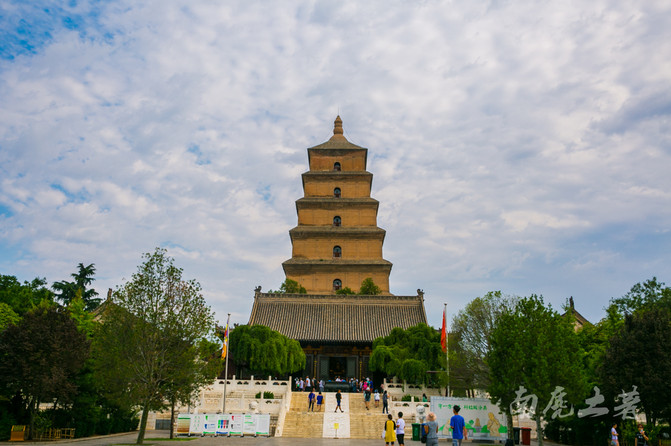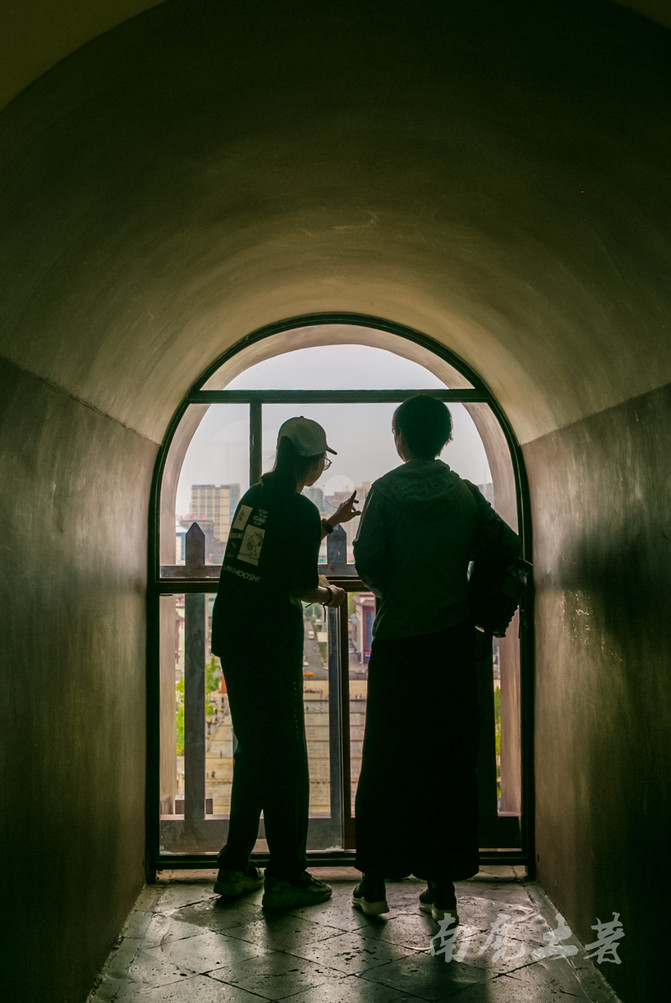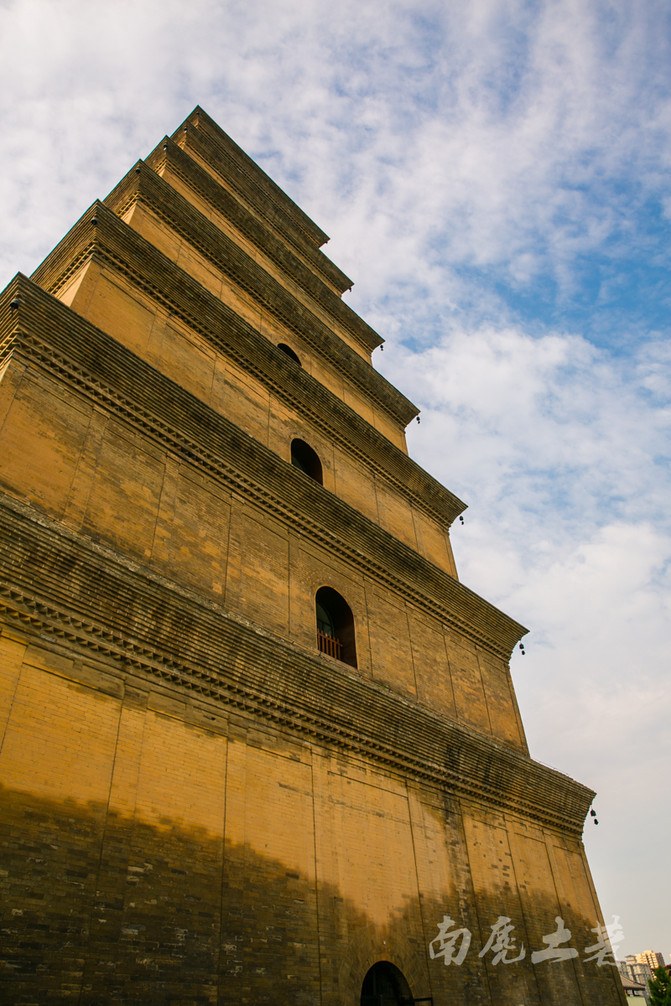The city's landmark building almost became China's Leaning Tower of Pisa

When I see the Big Wild Goose Pagoda, I think of Journey to the West, and when I think of Journey to the West, I think of the Tang Priest. The Big Wild Goose Pagoda, which stands on the outskirts of the ancient city of Xi'an, is a physical monument where the Tang Priest scriptures from the Western Heaven.
The blending of Chinese culture and the Western Regions

The Big Wild Goose Pagoda Scenic Area opens at 8 o'clock in the morning, and the entrance is already crowded with people at 7 o'clock. The summer tourist season makes this landmark building in Xi'an even more popular. While the tour group was still gathering the crowd, I took the lead in rushing in.

The ancient city may have the temperament of an ancient city. A plump woman wearing oil-paper flower umbrellas and elegant Tang suits and Chinese costumes float past us from time to time, taking us from the present to the long river of history.

The Big Wild Goose Pagoda was built in Dacien Temple, also known as the "Cien Temple Pagoda". It was built under the supervision of Tang Priest Xuanzang to preserve the Buddhist scroll Buddha statues brought back to Chang 'an from Tianzhu via the Silk Road. Xuanzang was born in Luoyang, Henan Province. At the age of 13, he followed his second brother to become a monk in Jingtu Temple in Luoyang. It is said that in the 13th year of Zhenguan of the Tang Dynasty, Emperor Taizong of the Tang Dynasty sought talents in order to explore the differences in the doctrines of various Buddhist sects. Xuanzang of the Tang Dynasty recommended himself and traveled far away to India. After hardships, he arrived at Nalantuo Temple, the center of Indian Buddhism, to retrieve the true scriptures. In the 17 years, he learned all the theories of the time, the great and the great temples.

Seventeen years later, Xuanzang returned to Chang 'an with 657 scriptures, eight Buddha statues and a large number of relics. After the completion of Dacien Temple, Xuanzang served as the first chief of the temple, built the Big Wild Goose Pagoda, and devoted himself to Buddhist translation. His main works include "Records of the Western Regions of the Tang Dynasty","Theory of Hui Zong" and "Theory of Controlling Evil", etc. He translated 75 Indian Buddhist scriptures with a total of 1335 volumes, especially the twelve volumes of "Records of the Western Regions of the Tang Dynasty", which describes his personal experience in traveling to the West. The mountains, rivers, cities, products, customs, etc. of 110 countries and rumored 28 countries have made great contributions to cultural exchanges between China and the Western Regions. The novel "Journey to the West" is based on Xuanzang's deeds of learning scriptures.

The Big Wild Goose Pagoda is one of the symbols of Chang 'an City in the Tang Dynasty that has been preserved to this day. It was originally modeled on the shape of the Western Regions with a brick surface and a soil core that cannot be climbed. Each floor contained relics. Later, it went through generations of reconstruction and repair, and gradually evolved from the original shape of the Western Regions with the characteristics of Central Plains architecture. It has become a brick imitation wood structure with the architectural characteristics of the Central Plains and a pavilions that can be climbed. This process vividly reflects the introduction of Buddhist architectural art into China and its gradual Sinicization. The stone tablets "Preface to the Holy Religion of the Great Tang Sanzang" and "Preface to the Holy Religion of the Great Tang Sanzang" stored in it further support the history of the spread of Buddhism along the Great Wild Goose Pagoda and the Silk Road.

However, no one knows where the treasures brought back by Xuanzang are kept. Some experts believe that there must be an underground palace underground under the Big Wild Goose Pagoda, which is very likely to contain Buddhist treasures brought back by Xuanzang.

The Big Wild Goose Pagoda was built by Xuanzang imitating the Indian Wild Goose Pagoda, so it follows the name of the Indian Wild Goose Pagoda. The word "big" is added before the name of the pagoda, which represents Mahayana Buddhism. The Big Wild Goose Pagoda was also the place where Jinshi was named in the Tang Dynasty. Later generations in Guanzhong used the title of "Yanta Title" to replace Jinshi.
The tower tilted, almost becoming a leaning tower

Climbing the tower, you can overlook the ancient city of Xi'an from the surrounding doorways. The North Square of the Big Wild Goose Pagoda starts from the southern end of Yanta Road in the north, connects to the north outer wall of Dacien Temple in the south, connects to Square East Road in the east, and connects to Square West Road in the west. The Big Wild Goose Pagoda is the central axis. The center is divided into three parts, and the center is the main scenic waterway. The left and right sides are divided into landscapes such as "Tang Poetry Garden Area","Faxiang Flower Bed Area", and "Zen Forest Tree Area". The southern end of the square is equipped with" Waterscape Falling"," Theme Water View Platform" and other landscapes.


Yesterday, on the south gate wall of the ancient city of Xi'an, looking south along Chang' an Avenue. The Big Wild Goose Pagoda was located in the middle of the end of the street, giving a sense of history that traveled through ancient and modern times.

The original architectural design of the Big Wild Goose Pagoda was modeled on India's famous and only Buddha worship tower-Buddha Gaya. It has 5 floors and 60 meters high. Later, Li Zhi, Emperor Gaozong of the Tang Dynasty, felt that this Indian-style building was a little inconsistent with the overall architectural style of Chang 'an City, so he renovated it and raised the Big Wild Goose Pagoda to 9 floors. During the Chang 'an period, the court built the Big Wild Goose Pagoda for the third time. Wu Zetian broke the practice of the Tang Dynasty that Buddhist pagodas had odd floors and raised the height of the Big Wild Goose Pagoda to an even number of 10 floors. In the second year of Changxing in the Later Tang Dynasty of the Five Dynasties, the Later Tang Dynasty renovated the Big Wild Goose Pagoda for the fourth time, and the Big Wild Goose Pagoda was restored to the seventh floor again.

Later, several major earthquakes occurred in Xi'an. The top of the Dayan Pagoda fell, the tower walls were cracked, and the tower body tilted. In the 32nd year of Wanli of the Ming Dynasty, the Big Wild Goose Pagoda was repaired for the fifth time. This was a major maintenance and reinforcement project. On the basis of maintaining the basic shape of the Tang Dynasty pagoda, the exterior is completely covered with a 60-cm-thick cladding. This is the Big Wild Goose Pagoda we see today.

After the founding of the People's Republic of China, the Big Wild Goose Pagoda was announced by the State Council as one of the first batch of national key cultural relics protection units. Various means were implemented to protect the ancient culture of the Big Wild Goose Pagoda. By sealing wells and recharging groundwater, the groundwater level rose was accelerated. Six groundwater recharge demonstration sites were built in the city of Xi'an to raise the groundwater level as soon as possible. After more than 20 years of comprehensive improvement, the tilt of the Big Wild Goose Pagoda has obviously eased and stabilized, and has gradually returned to correction.
